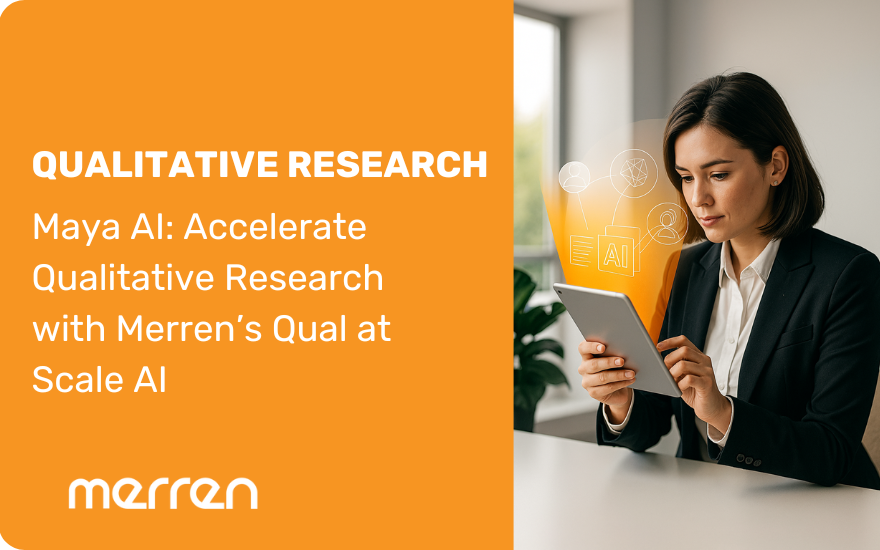Traditional market research needs human professionals. Not just that but it is time and expertise consuming. The entire experience can take days and months depending on how complex the research process is. It starts from having a goal , creating questions, deciding sample size and means and methodologies to conduct the qualitative research.
To augment human researchers, Merren has built Maya AI from the ground up, a powerful qualitative research assistant designed to make market research faster, smarter, and far less intimidating than traditional qualitative research.
What is Maya AI?
Maya AI is Merren’s AI-powered customer research platform that is meant to augment human researchers. Maya does not replace you, she enables you to expedite your work with AI-tools. It offers the scale of quantitative research with the depth of qualitative research.
Why does Maya AI matter in 2025 and beyond?
Speed of your research is everything. Markets shift overnight, new trends come in and spread across platforms. Organisations must not rely solely on traditional surveys or intuition for decision-making. Yet, traditional qualitative research remains slow, expensive, and localized, often limiting access to timely insights.
Recent breakthroughs in AI, NLP, and large language models (LLMs) have transformed how we gather and interpret data. Merren saw an opportunity to apply these technologies to qualitative research, creating Maya, an AI designed to conduct meaningful research conversations at scale.
Here is What Maya AI Can Do For You
All you have to do is determine your research objective. Maya AI takes over from here to reduce cognitive burden.
- Designs the discussion guide
- Identifies the right participants
- Conducts interviews via chat or voice
- Analyzes results using AI-driven analytics
Maya can handle conversations in dozens of languages, allowing you to listen to your global audience authentically.
Within hours, not weeks, you receive:
- Transcripts of every conversation
- Automatically identified key themes and sentiments
- Audio or video snippets of insights ready for presentations
One of our beta users summed it up perfectly:
“It’s like going from horse-and-buggy to electric car in research. We could suddenly do five projects in the time it used to take one.”
Qualitative Research: Maya AI vs Traditional Research
Here is how Maya AI stacks up against traditional qualitative research methods:
Dimension | Traditional Qualitative Research | Maya AI by Merren |
Time to insights | Often weeks to months: planning, recruiting, moderating, transcribing, analysing. | Hours instead of weeks. Maya auto-generates guides, conducts interviews, and analyses in real time. |
Scale of study | Small sample sizes (e.g., 6-10 in-depth interviews, a few focus groups). Depth over breadth. | Can run hundreds of interviews simultaneously across languages / time zones. |
Recruitment & execution logistics | Manual recruitment, moderator scheduling, in-person or remote set-ups, often costly and time-consuming. | Automated set-up: define objective → Maya designs guide → deploy interviews via chat/voice with minimal coordination. |
Moderator/interviewer consistency | Varied across moderators: style, fatigue, bias can affect how interviews are conducted. | Consistent interviewer persona, tone and follow-up built in; uniform experience across respondents. |
Language / global reach | Often limited: multiple languages = more cost, translations, local moderators. Often localised only. | Multilingual support built in: conversations, transcription and translation across many languages and markets. |
Data processing (transcription, coding, themes) | Manual transcription → manual coding (open/axial/selective) → theme development. Time & resources are heavy. | Automated transcription, real-time theme clustering, sentiment/emotion detection and dashboard reporting. |
Depth of insight / human nuance | High depth: you capture rich narratives, context, non-verbal cues, “why” behind behaviour. | High depth with greater scale: Maya aims to replicate skilled moderator probing and adapt follow-up questions in real time. |
Cost / resource requirements | Generally expensive: human moderators, transcription services, travel (if in-person), translation, analysis tools. | Lower per-interview cost (because of automation) and less human overhead. enables more frequent qual research. |
Flexibility / speed to iterate | Slower to adapt: once guide is set, recruiting/moderating/transcribing takes time; fewer iterations possible. | Agile: quickly refine guide, deploy more interviews, get insights fast — enabling quicker cycles of learning. |
Ideal for… | Deep, exploratory work with small, targeted samples; when context matters and you have time & budget. | When you need qualitative depth and speed/scale — global reach, multilingual, agile cycles of insight. |
The Future of Qualitative Research
Qualitative research is no longer limited by geography, time, or human bandwidth. It’s a fusion of human empathy and AI efficiency. With Maya AI, marketers, CX professionals, and researchers can use this power to uncover deep insights at an unprecedented scale.
Maya is not here to replace the researcher; she’s here to amplify your capability to understand people: faster, deeper, and smarter. Want to explore how Maya AI can amplify qualitative research for you? Click here.

